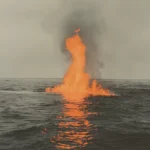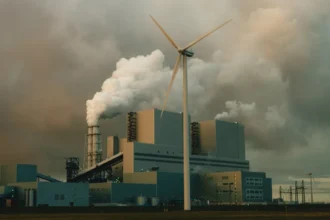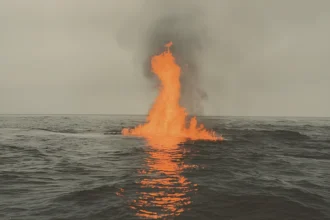Scientists Plan to Thicken Arctic Ice to Fight Climate Change
What if we could save the Arctic ice by making it thicker using pumps and seawater? This might sound like science fiction, but it’s exactly what scientists are planning to test soon. Researchers from the University of Cambridge’s Centre for Climate Repair are developing a bold plan to artificially thicken Arctic sea ice to slow down climate change, according to information from the DailyMail.
Why Arctic Ice Matters and Why It’s Disappearing
The Arctic region is covered with sea ice that works like a giant mirror, reflecting sunlight back into space and helping keep Earth cool. However, this ice is melting faster than ever before due to global warming. Scientists now predict that the Arctic could be completely ice-free during summer months as early as the 2030s – just a few years from now.
When ice disappears, the dark ocean water absorbs more sunlight instead of reflecting it, which makes the Arctic warm up even faster in a dangerous cycle. This is why researchers are looking for ways to save the ice before it’s too late.
How the Ice-Thickening Technology Would Work
The proposed solution is surprisingly straightforward in concept: pump seawater onto the existing ice surface during winter. Steven Desch from Arizona State University first suggested this approach in 2016, and now scientists are getting ready to test it.
There are two main methods being considered:
- The first method involves directly pumping seawater onto the ice surface, where it would freeze due to the cold Arctic temperatures, adding extra thickness to the ice that’s already there – like adding extra layers to a cake to make it taller and stronger.
- The second approach focuses on filling snow voids (empty spaces between snow particles) with seawater. Snow naturally acts as an insulator, but by filling these spaces with water that freezes, scientists can convert fluffy snow into solid ice, creating a much denser and more durable ice layer.
Previous small-scale tests have already shown promising results, with researchers able to thicken ice by 50 centimeters (about 1.6 feet). Andrea Ceccolini from Real Ice told New Scientist, “Our objective is to demonstrate that ice thickening can be effective in preserving and restoring Arctic sea ice.”
The Massive Scale: Understanding What 10% of the Arctic Means
The scientists aren’t planning to thicken all of the Arctic ice – that would be impossible with current technology. Instead, they believe targeting about 10% of the Arctic region could make a meaningful difference.
But what does 10% of the Arctic actually look like? The Arctic region covers about 14.5 million square kilometers in total – an enormous area. Here’s what the planned scale means:
| Measurement | What It Means |
|---|---|
| 10% of Arctic = approximately 1.45 million square kilometers | This is about half the size of India or roughly equivalent to the combined area of France, Germany, Spain, and Italy together. It’s an enormous undertaking. |
| 500,000 pumps needed | Scientists estimate they would need about half a million pumps to thicken roughly 386,000 square miles (about 1 million square kilometers) of ice each year. |
| Area comparable to half of Alaska | The area that could be thickened annually is approximately half the size of Alaska, giving you an idea of the massive scale of this project. |
Research suggests that thickening ice by just 1 meter each winter in this 10% area could offset all the ice thinning that has happened since 2000. Models from Real Ice estimate this approach could maintain current summer sea ice levels of about 4.2 million square kilometers by targeting different areas each year.
Timeline and Research Progress
The project has received substantial financial backing, with the UK government providing £57 million in funding for geo-engineering research. This significant investment shows how seriously governments are taking alternative approaches to fighting climate change.
The timeline for this project is moving quickly:
- Field trials are scheduled to begin in Canada in 2025, where researchers will test their ice-thickening methods in real-world conditions to see if they can be scaled up effectively.
- These tests will build upon previous pilot studies that successfully demonstrated the ability to thicken ice shelf by 50 centimeters in controlled environments.
- The urgency comes from predictions that the Arctic could experience ice-free summers by the 2030s, giving scientists less than a decade to develop and implement solutions.
Potential Environmental Risks and Concerns
While the technology sounds promising, experts have raised serious concerns about potential negative consequences of artificially manipulating Arctic ice on such a large scale.
Environmental organizations like the World Wildlife Fund (WWF) have warned that geoengineering projects could introduce new problems to the fragile Arctic ecosystem:
- The introduction of massive human industrial activity in the Arctic could bring pollution, noise, and physical disturbances to an environment that has remained relatively untouched. This is like suddenly bringing a construction site to a pristine natural area.
- The Arctic’s marine biology is extremely sensitive to changes. The ice-thickening process could alter the natural freezing patterns that many organisms depend on, potentially disrupting the entire food web from tiny plankton to polar bears.
- The Center for International Environmental Law warns that large-scale geoengineering could irreversibly affect biodiversity by changing nutrient cycling in the ocean, which would impact everything from microscopic organisms to fish populations.
Impact on Local Communities
Beyond environmental concerns, there are important considerations about how this technology could affect people living in the Arctic, particularly indigenous communities.
Many indigenous peoples in the Arctic have traditional ways of life that depend entirely on hunting and fishing. Changing the natural ice patterns could affect:
- Traditional hunting routes and practices that rely on specific ice conditions and timing – artificial ice might behave differently than natural ice.
- Fish migration patterns and availability, which could impact food security for communities that depend on these resources.
- The biochemical composition of the marine environment, potentially affecting the health and abundance of the animals these communities rely on for survival.
Balancing Technology and Traditional Climate Solutions
Perhaps the biggest concern raised by critics is that focusing on technological fixes like ice thickening might distract from the more fundamental need to reduce greenhouse gas emissions. Some environmental experts worry that governments might view these technologies as an “easy fix” and reduce efforts to address the root causes of climate change.
The debate highlights the complex choices facing humanity as we confront climate change. Is it better to focus entirely on reducing emissions, or do we need both emission reductions and technological interventions to buy us time?
Looking Ahead: What’s Next for Arctic Ice Preservation
As the 2025 field trials in Canada approach, scientists will be working to answer many questions about the feasibility, cost, and environmental impact of large-scale ice thickening. The results of these tests will be crucial in determining whether this approach becomes a major strategy in fighting climate change or remains an interesting but impractical idea.
What’s clear is that the rapid loss of Arctic ice represents one of the most visible and concerning effects of our warming planet. Whether through innovative technologies like ice thickening or through traditional approaches like reducing emissions, finding ways to preserve this crucial part of Earth’s climate system remains an urgent priority for scientists around the world.











